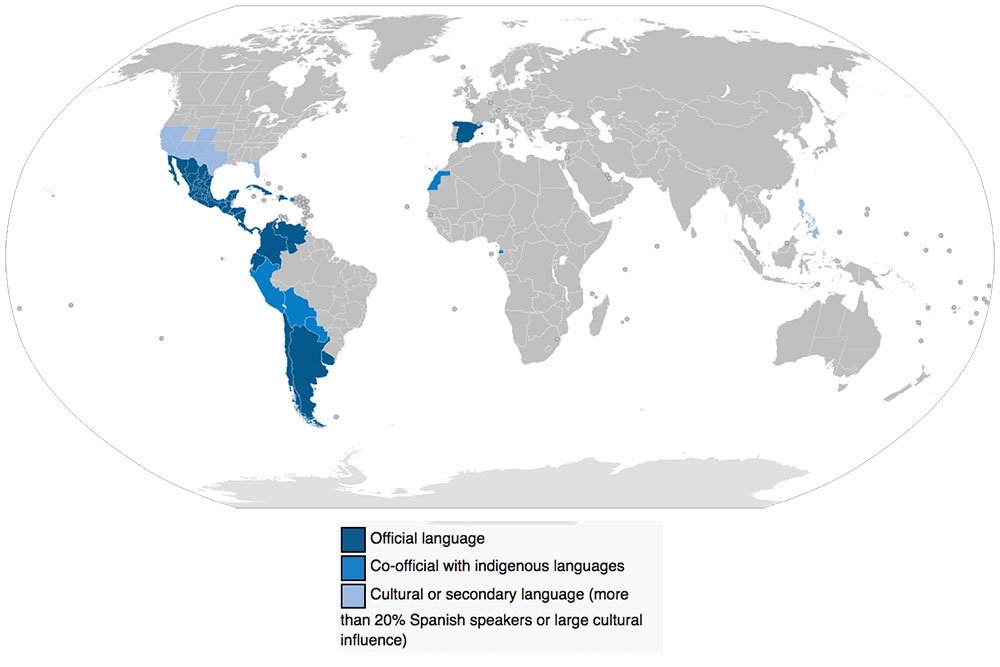What makes the Spanish language special?
There are 142 different language families, and a total of 7,151 languages are spoken today. 40% of those languages are endangered, and only 23 languages account for more than half the world’s population.
Of those 23, Spanish is the second most spoken language in the world. It’s a language gaining popularity among non-native speakers due to its usefulness and charming sounds.
Spanish is a beautiful and rich language. It has different accents and dialects, immense and unique vocabulary, and represents the Spanish and Latin American cultures.
It is a unique and special language. Do you want to know why?
In today’s article, we will go through interesting facts that explain why the Spanish language is special.
Let’s begin!
The Spanish language around the world
According to the 2019 report from the Instituto Cervantes, more than 580 million people worldwide speak Spanish. This includes native speakers (483 million) and non-native speakers (97 million).
Spanish today is Spoken in 3 out of the world’s five continents. It’s the language -or one of the official languages- of 21 Countries (including Puerto Rico).

Here are seven interesting facts about the Spanish language around the world:
- Although Spain is where Spanish originated, it is not the country with the larger number of native speakers. Spain accounts for less than 10 percent of the world’s Spanish speakers (more than 46 million).
- More people speak Spanish in the United States than in Spain. There are roughly 53 million Spanish Speakers in the United States; approximately 41 million native Spanish speakers and 11.6 million speak Spanish as a second language.
- Spanish is expected to be the first language of 50% of the population of the United States within 50 years.
- There’s a Spanish-based creole language spoken in the Philippines called Chabacano. It’s the sole and most extensive Spanish-based creole language that still exists in Asia or Oceania.
- There is one country in Africa where nearly 68% of the country’s population speaks Spanish. This country is Equatorial Guinea.
- Spanish is one of the six official languages of the United Nations.
- Spanish is the third most used language on the Internet.
Unique characteristics of the Spanish language
Now, let’s talk about some of the characteristics of the Spanish language in terms of grammar and linguistics that makes it a unique language.
1. The letter ñ, a unique letter in “español”
The letter “ñ” is a letter that only exists in Spanish. The sound /ɲ/ did not exist in Classical Latin but Vulgar Latin. This was the language spoken in the streets and from which the Castillan Spanish originated.
As the sounds began to evolve, the /ɲ/ sound appeared, and different solutions were given to write this new sound: “ni + vowel”, “gn” and “nn”.
Those three options coexisted until the medieval scribe monks, who copied texts by hand, started to use a symbol called virgulilla (~) to indicate that it was double “nn” (anno > año). From that moment on, the letter “ñ” replaced all other representations of the new sound.
Currently, the letter “Ñ” is used in more than 15,700 words in the Spanish language. Some of the most common words are:
Año, araña, baño, buñuelos, cariño, español, mañana, montaña, muñeco, niño(a), piña, señor(a), sueños, tamaño.
2. All Spanish vowels are pronounced in the same way
One of the great things about Spanish is that it is written pretty much as it sounds, with just a few exceptions.
In Spanish, we use five vowels, which never change their sound. There aren’t neutral vowels, nasal vowels, or open vowels, as there are in many other languages. This makes Spanish an easy language to learn and master.
A: Amiga (female friend), antiguo (old), abanico (fan)
E: Elefante (elephant), entonces (then), electricidad (electricity)
I: Iglesia (church), inteligente (intelligent), implicito (implied)
O: Oso (bear), odisea (Odyssey), ombligo (belly button)
U: Ucrania (Ukraine), Úrsula (Ursula), Uno (one)
3. A unique way to use exclamation and question marks
Spanish is the only language that uses inverted exclamation and question marks.
In Spanish, we use:
An inverted question mark (¿) at the beginning of a question, and a question mark (?) at the end of the question.
Why?
In Spanish, the word order of a question does not change as it does in English and other languages.
For example, we say:
Pablo compró un carro. – Pablo bought a car.
¿Pablo compró un carro? – Did Pablo buy a car?
So, in the written texts, it is necessary to use the inverted question mark to indicate to the reader that a question is coming next.
Likewise, an inverted exclamation mark (¡) at the beginning of all exclamatory sentences and clauses, and an exclamation mark (!) at the end of such sentences.
Inverted exclamation marks are used to identify the tones of the sentences within a text body easily.
For example, we say:
Por fin terminé mis actividades de la semana ¡me voy de vacaiones!
I finally finished my weekly activities. I’m going on holiday!
4. Pronouns are not always used in all the sentences
Pronouns in Spanish are not used in every sentence, as in English and other languages. They are often essential, but their use should be avoided when it is not necessary.
Overusing Spanish pronouns (i.e. yo, tu el, ella, nosotros, ustedes, ellos, ellas) is one of the most frequent mistakes new Spanish learners make.
In Spanish, the context and verb forms often make subject pronouns unnecessary since they imply who is performing the action.
For example:
CORRECT:
Voy al supermercado – I am going to the supermarket.
¿Vas al supermercado? – Are you going to the supermarket?
UNNECESSARY:
Yo voy al supermercado – I am going to the supermarket.
¿Vas tú al supermercado? – Are you going to the supermarket?
When you use the verb form “voy” or “vas” it already implies that it is referred to as the pronoun “I” and “you”. Thus, its use is unnecessary unless you want to emphasize who is going to the supermarket.
5. Unique words
The Spanish language is so rich, we have many words that simply don’t have a translation in English.
For example:
- Estrenar: To use for the first time, brand new
- Madrugar: To wake up early
- Transnochar: To stay up late, to go to bed late.
- Tutear: To treat someone informally by addressing them as “tú” instead of the more formal “usted.”
Read our article “10 Spanish Words that can’t be translated into English” to learn more unique words!
Te quiero & Te amo
Expressions like “Te quiero” and “Te amo” have a deeper meaning in Spanish than in English.Te quiero” and “Te amo” can both mean “I love you”. The difference is that “Te amo” is considered more intimate, while “Te quiero” is considered more casual.
Verbs Ser & Estar
In Spanish we use two different verbs for the verb “to be”: Ser and Estar. The first one is for permanent states, and the second one is for temporary states.
- Ser: is used for the personality features of a person.
For example:
Yo soy alto – I am tall
Eres inteligente – You are smart - Estar: is used for temporary states.
For example:
Estoy en casa –I am at home
Estoy triste – I am sad
Tu, usted and vos
In Spanish, we use three variations of the pronoun “You”, depending on the region:
- Usted: Formal
- Tú: Informal
- Vos*: Informal and less used.
*In Colombia only used in Medellin, Cali, and their surrounding areas. And frequently used in Argentina for formal and informal conversations
Come learn this unique language with us!
We hope you have learned and enjoyed reading this article. Visit our Blog and follow our Social media to learn more about the Spanish language and Colombian culture.
If you want to learn Spanish or improve your current level, join any of our classes, online or in-person.
See you soon!











